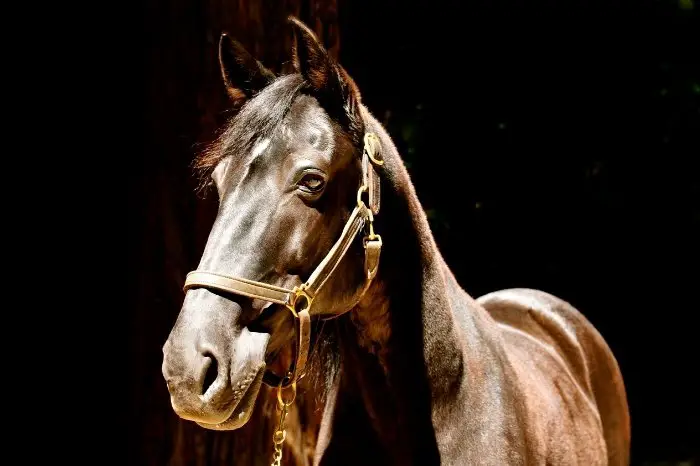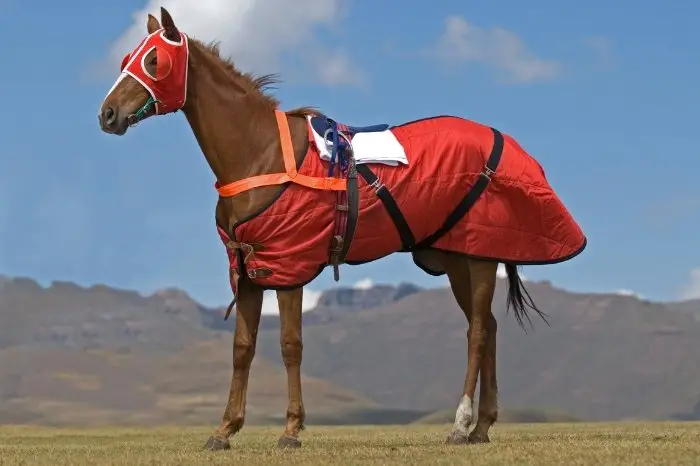Last Updated on March 29, 2022
Each individual horse is very different in personality, with its own character and quirks. This gives each horse a unique temperament, but we can classify them by using a horse temperament scale.
You may have heard horses described in terms such as fizzy, hot-headed, and placid, but this doesn’t help us to compare one horse against another. Let’s take a look at how a horse temperament scale works and see how different types of horses fit into it.
What Is A Horse Temperament Scale?
In recent years, much scientific research has gone into establishing a consistent and reliable horse temperament measurement. A horse temperament scale is an assessment of the temperament of an individual horse or horse breed. This assessment is then used to determine where the horse sits on a temperament scale, enabling us to compare it against other horses.
Researchers have tried to create temperament analysis tools that give consistent and repeatable results. However, they have found that some people struggle to objectively analyze a horse’s temperament, favoring certain breeds or types over others.
A horse temperament scale will normally range from 1 – the calmest type of horse – to 10, which would be the most excitable type of horse. Let’s take a look at the personality traits of horses and how they affect where they score on the horse temperament scale.
Horse Temperament Scale Explained
The horse temperament assessment is based on the calmness or excitability of a horse or pony. These can be split into two broad groups:
-
Calm, Bombproof Personality Traits – Score Of Under 5
These horses are often described as dependable and placid. They will not throw many surprises your way, and you can normally predict how they will behave. Calm horses tend to be cold-blooded breeds such as draught horses, or warm-blooded breeds crossed with a cold-blooded breed.
Horses which score 5 or below on the horse temperament assessment are normally best suited to novice or nervous riders. They will take care of their jockey and normally need urging on rather than holding back. These horses tend to be more muscular and heavily built, designed for hard labor rather than athletic performance.
-
Excitable, Fizzy Personality Traits – Score Of 5 Or Above
This is the other end of the spectrum! Horses which score 5 or above on the horse temperament assessment are lively, energetic, and raring to go. They will be less predictable and will keep us on our toes, especially in unfamiliar situations.
Horses with a high score on the temperament scale are normally warm or hot-blooded breeds. They are more suited to experienced riders. These horses can often excel in athletic spheres such as showjumping and racing.
Formula 707 Calming Equine Supplement 10LB Bucket – Anxiety Relief and Enhanced Focus for Horses
Horse Breed Temperament- Where Do Popular Breeds Fit On The Horse Temperament Scale?
Although all horses are different, certain breeds are renowned for their specific temperaments. Let’s take a look at some popular horse breeds and see how they score on the horse temperament scale!
-
Thoroughbred Horse Temperament
Thoroughbred horses are the kings and queens of the horse racing world! They are fast, athletic, and intelligent animals, normally suited to more experienced riders. This breed would normally come quite high on the horse temperament scale, scoring 7 or above.
There are exceptions to this, and occasionally you will come across a Thoroughbred with a calm and sensible temperament.
-
Shire Horse Temperament
Shire horses are the workhorses of the equine world. These gentle giants were originally bred to carry out heavy farm work, such as plowing and pulling heavy loads.
Shire horses score very low on the horse temperament scale, coming in at between 1 and 3. However, their large size means that they can still be difficult to handle, purely due to their immense strength!
-
Standardbred Horse Temperament
The Standardbred horse is one of the ultimate all-rounders and falls midway on the horse temperament scale. This calm and sensible horse will look after the most nervous riders, but also has enough of a spark to be a fun and exciting ride for a more experienced jockey.

-
Quarter Horse Temperament
Quarter Horses are calm and docile, with a temperament that scores between 3 and 5. They are very intelligent and easy to train, without being too excitable or unpredictable. This makes the Quarter horse a popular choice for a range of different equine sports, particularly reining and ranching.
-
Friesian Horse Temperament
The Friesian horse is a bit of an oddity when it comes to temperament. Although they are similar to a light draft horse in build and stature, they have an excitable and lively nature and can be difficult to handle. These bold and flashy horses definitely score quite highly on the horse temperament scale, sitting between 6 and 8.
Which Is The Best Temperament For A Horse?
The best temperament for a horse depends on what it is to be used for, and the personal preference of the owner or rider. A nervous or novice rider will need a calm and predictable horse who is at the lower end of the temperament scale.
Riders who want to compete at a higher level will normally opt for a horse with a temperament score of 5 to 7 – sensible but with a bit of fizz and boldness! These are horses which are intelligent and hard-working and will respond well to pressure in a competition situation.

The liveliest horses are only suited to very experienced horse people, as they can be dangerous and difficult to manage. Among these horses includes some of the top-level racehorses and equine athletes, and if managed correctly these bold and fiery horses can achieve great things.
Temperament Scale For Horses- Summary
So, as we have learned, the horse temperament scale is an assessment of how calm or excitable a horse is. This scale ranges from 1, a bombproof cob or draught horse, up to 10 – normally a fizzy hot-blooded breed such as an Arabian or Thoroughbred!
We would love to hear about your horses and ponies, and where you think they fit on the horse temperament scale. Or maybe you have known a horse that completely breaks the mold when it comes to an extreme temperament. Add a comment below this post and we’ll get back to you!
What is the calmest breed of horse?
The American Quarter horse is generally regarded as one of the calmest and quietest breeds of horses, so named because it can run a quarter mile in the shortest time. The American Quarter horse is a versatile horse that can be used for pleasure riding, ranch work, driving, and even pulling a cart. It has a friendly personality that makes it a favorite among children and adults alike. Quarter horses are also known to be relatively easy to handle. They are docile, easy to train, and have a friendly demeanor. They do not spook easily, and are rarely aggressive unless they are frightened or abused. They are also known for their longevity and high reproduction rate.
What does the swirl on a horses head mean?
A swirl between the eyes is a trademark of an easy going, uncomplicated horse. Swirls positioned higher on the forhead are linked to self-motivation, responsiveness, and intelligence. Swirl that is long, and even more if it extends below the eye level, indicates a friendly and agreeable nature.
A star is another mark that can give you some info about your horse’s personality. A star above the eyes indicates a high energy horse. A star that is located low on the forehead is indicative of a calm, collected horse. Stars can also be found in other areas of the body, such as the neck, shoulders, and flanks, indicating that the horse possesses some energy.
What does it mean if a horse has two swirls?
Multiple swirls on the forehead often indicates multiple personalities. Multiple swirls positioned high and close together side by side are strong signs of a difficult horse, but in the right hands they can be very rewarding as they are normally very focused and talented. When a horse has two swirls on the forehead on top of each other, that can indicate extreme personality swings and unpredictability.
What does it mean when a horse has a kind eye?
Most people would agree that the proverbial large, soft, kind eye is highly valued for good reason as it indicates trust and willingness. When a horse has a kind eye, it means he or she is gentle, patient, and kind. Horses with kind eyes are usually more receptive to training and are more likely to follow your commands. On the other hand, an eye that makes the horse appear nervous or suspicious of you for no apparent reason indicates anxious temperament and a lack of trust. These horses might be more challenging to train and ride and are not the best choice for beginner riders.
Is a gelding or mare better for a beginner?
When it comes to riding, geldings are slightly more suitable for beginners than mares. The reason for this is that geldings have less mood swings than mares because they don’t experience hormonal changes. The best choice for a horse depends on the horse’s age, temperament, and how late in life it was gelded. Horses that have been gelded earlier in their life are more suitable for beginners than horses that were gelded after reaching adulthood.

Kate Chalmers is a qualified veterinary nurse who has specialized in horse care for the vast majority of her career. She has been around horses since she was a child, starting out riding ponies and helping out at the local stables before going on to college to study Horse Care & Management. She has backed and trained many horses during her lifetime and competed in various equestrian sports at different levels.
After Kate qualified as a veterinary nurse, she provided nursing care to the patients of a large equine veterinary hospital for many years. She then went on to teach horse care and veterinary nursing at one of the top colleges in the country. This has led to an in-depth knowledge of the care needs of horses and their various medical ailments, as well as a life-long passion for educating horse owners on how to provide the best possible care for their four-legged friends.
Kate Chalmers BSc (Hons) CVN, Dip AVN (Equine) Dip HE CVN EVN VN A1 PGCE

